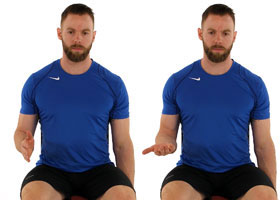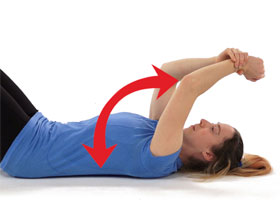- Reference Number: HEY239/2021
- Departments: Orthopaedics
- Last Updated: 31 January 2021
Introduction
This leaflet has been produced to give you general information about your injury. Most of your questions should be answered by this leaflet. It is not intended to replace the discussion between you and the healthcare team, but may act as a starting point for discussion. If after reading it, you have any concerns or require further explanation, please discuss this with a member of the healthcare team.
What is a soft tissue injury?
The term soft tissue refers to muscles, ligaments and tendons that surround and support our joints. Injuries to the soft tissue around the elbow can be caused by a fall onto an outstretched hand, overuse or direct impact.
What are the symptoms?
A soft tissue injury to the elbow may result in the following:
- Pain
- Heat, redness or bruising
- Swelling
- Stiffness and loss of function
Pain relief
To manage your pain, it is advised that you regularly take simple pain relief which can be bought over the counter from your pharmacist. If you have allergies or conditions which prevent the use of pain relieving or anti-inflammatory medication, please seek advice from your doctor or a pharmacist.
What should I do in the first 72 hours after the injury?
The most important initial treatment is aimed at controlling the pain and swelling by following the principles of RICE:
R – Rest
Complete rest is not advisable but it is important that you prevent putting the elbow under strain in the early stages of healing. Ensure you continue to move the shoulder, wrist and fingers as normal, as it is common to quickly become stiff in these areas.
You may be given a sling but this should be discarded as soon as the pain is under control, this is usually within 72 hours.
I – Ice
Ice will help reduce the pain in your elbow and so should be applied for 10 to 15 minutes. This will help to reduce the swelling.
There are many different ways in which ice can be applied however it believed crushed ice, in the form of frozen peas for example, is the most effective. Whichever method you choose it is important that you wrap the ice in a damp towel, in order to prevent it from ‘burning’ the skin.
Please note:
Only use an ice pack on areas that have normal skin sensation i.e. where you can feel hot and cold.
Do not apply over an open wound.
Do not apply an ice pack to an area that has poor circulation.
When you apply ice to your skin, check the skin every five minutes and stop using it if:
- the area becomes white, blue or blotchy.
- the area becomes excessively painful, numb or tingles.
C – Compression
You may have been given a tubigrip to wear to help control your swelling. It is important this is removed if you develop any signs of poor circulation such as tingling, numbness, blueness of the skin of the arm or hand and increasing pain. The tubigrip should be removed when you go to bed at night as when you are asleep you cannot monitor these symptoms.
E – Elevation
If you have swelling in your wrist or hand sit on a chair and place your elbow on cushions so that it is level or slightly higher than your shoulder. In this position point your hand towards the ceiling then open and close your hand as this will help to reduce any swelling further.
What not to do
Consuming alcohol, massaging the injured area and applying heat can all be detrimental in the early stages of healing and therefore should be avoided. It is important to note that smoking may also delay the healing process.
Rehabilitation and recovery
If you follow this basic advice your injury should take around six weeks to heal. However, everyone recovers from injuries at different rates and it is dependent on the severity of the injury and the presence of any other medical problems. It is possible that you may be back to normal in two weeks. However, it is also possible you may suffer symptoms for up to three months.
After 72 hours it is very important you try to start using your elbow normally again when doing everyday tasks like washing and dressing. The exercises below will help you to regain full function, flexibility and strength.
|
|
|
|
Feel it stretching and hold this for 10 seconds
Still in the same position straighten it out as far as you are able, but do not force. |
| 2. Bend your elbow and tuck it into your side. | |
 |
Turn your palm as far as possible upwards without moving your elbow. Feel the stretch and hold for 10 seconds
Now turn your hand back over so your palm faces downwards, feel the stretch and hold for 10 seconds |
| You may find that your wrist and shoulder joints feel stiff too. Doing the exercises below will help to improve this: | |
|
|
 |
Hold the stretch 10 seconds in each direction. Repeat 10 times |
|
|
 |
Use the uninjured arm to assist the injured arm to lift it out in front of you as high as possible.
Hold at highest point for 10 seconds |
You should try to practice these 10 times, three to four times every day. You may experience more discomfort when you start the exercises. However, this is normal and does not mean you should stop.
All photos with kind permission of ©Physiotec™
If your symptoms remain worse for more than two hours after the exercises then you should decrease the number of each exercise that you do and build up again slowly.
Repetitive elbow movements and lifting objects heavier than a teacup should be avoided to begin with. As your movement improves and pain reduces, little by little you can increase the amount of weight that you are able to lift; this should be done sensibly. Progressing from lifting a tea cup to a heavy shopping bag for example would not be advisable as it is likely to result in overloading of the soft tissue and could consequently lead to a further injury.
When can I return to normal activities?
If your job involves regular activities using your elbow you must ensure that you practice similar tasks so that you build your strength and function up gradually.
If you participate in an active hobby then it is advised that you do not return to this until you have full strength, full range of movement and you can use your elbow normally without experiencing pain or swelling.
If you play a sport, practice specific activities like throwing a ball to prepare the elbow. Build these activities up gradually before returning to full training sessions and competition.
Do I require further treatment?
You may be advised that you require physiotherapy following this type of injury, unless your symptoms are minimal on your initial appointment. Your physiotherapy could be at a variety of locations in the Hull and East Riding area.
You can self-refer to physiotherapy by contacting the following number depending on the location of your doctor:
- Hull GP patients self-refer to Healthshare: tel: 01482 300003
- East Riding GP patients self-refer to East Riding Physiodirect: tel: 01377 208300 or self-refer online at chcpmsk.org.uk
On occasions the clinician may wish to refer you to the physiotherapy team within the hospital trust. If this is the case they will advise you of this and you should receive an appointment at Hull Royal or Castle Hill Hospitals within 5 to 7 days of your attendance at the Emergency Department. If you have received no contact within this time please call the physiotherapy admin team on tel: 01482 674880.
When to seek further help
If 10 days following your injury you are unable to use the elbow and it remains painful and swollen, despite following the above advice, please contact the physiotherapy team that you were advised to contact in the section above.


